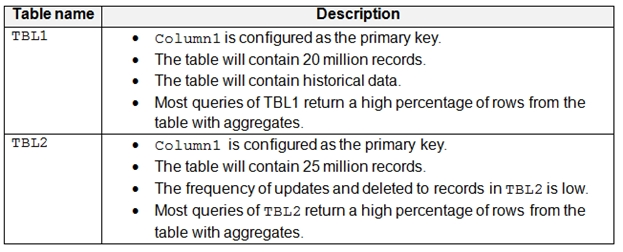

Note: This question is part of a series of questions that use the same or similar answer choices. As answer choice may be correct for more than one question in the series. Each question is independent of the other questions in this series.
Information and details provided in a question apply only to that question.
You have a Microsoft SQL Server database named DB1 that contains the following tables:
There are no foreign key relationships between TBL1 and TBL2.
You need to minimize the amount of time required for queries that use data from TBL1 and TBL2 to return data.
What should you do?
EdwardWang
Highly Voted 5 years, 5 months agoNew_user
5 years, 4 months agoals2kool
5 years, 3 months agoJohnFan
5 years, 3 months agoMML
4 years, 11 months agovirgo999
5 years, 2 months agoHoglet
Highly Voted 4 years, 12 months agoMML
4 years, 11 months agostm22
4 years, 11 months agoeggzamtaker
Most Recent 4 years, 5 months agoSoupDJ
4 years, 7 months agolh2607
4 years, 7 months agoSoupDJ
4 years, 7 months agoCococo
4 years, 9 months agoCristianCruz
4 years, 9 months agoeggzamtaker
4 years, 5 months agomelvin9900
4 years, 10 months agomelvin9900
4 years, 10 months agomelvin9900
4 years, 10 months agojulie2020
4 years, 9 months agogeekeek1
4 years, 5 months agoMML
4 years, 11 months agoHoglet
4 years, 12 months agogtc108
5 years, 2 months agorya
5 years, 3 months agoTwigit
5 years, 3 months agoJohnFan
5 years, 2 months ago